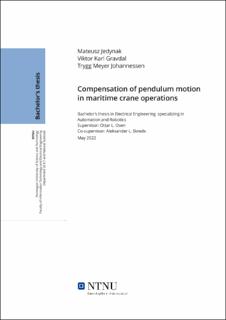| dc.contributor.advisor | Osen, Ottar | |
| dc.contributor.advisor | Skrede, Aleksander | |
| dc.contributor.advisor | Hasan, Agus | |
| dc.contributor.author | Meyer Johannessen, Trygg | |
| dc.contributor.author | Karl Gravdal, Viktor | |
| dc.contributor.author | Jedynak, Mateusz | |
| dc.date.accessioned | 2022-08-26T17:19:34Z | |
| dc.date.available | 2022-08-26T17:19:34Z | |
| dc.date.issued | 2022 | |
| dc.identifier | no.ntnu:inspera:110437709:110437919 | |
| dc.identifier.uri | https://hdl.handle.net/11250/3013918 | |
| dc.description.abstract | Denne rapporten omhandler utvikling av en prototype, med et formål å undersøke kompensasjon for nyttelastsving på en maritim kran. Rapporten beskriver hvordan flere komponenter er implementert for å produsere prototypen til denne bacheloroppgaven.
En 6-leddet robotarm brukes som prototype for en fysisk kran. Nyttelasten til prototypen er kjent. Nyttelastens bevegelse og dynamikk er modellert ved hjelp av lagrangiansk mekanikk. Kinematiske ligninger som definerer robotens bevegelser oppnås analytisk. Maskinsyn brukes til å oppdage nyttelastposisjonen. Flere deteksjonsalgoritmer utforskes, der fargedeteksjon brukes i prototypens endelige versjon. Ulike kamera-monteringer undersøkes. Først på gulvet, så på prototypens ende effektor. Flere kontrollsløyfer er simulert basert på den dynamiske nyttelastmodellen. I tillegg er flere kontrollere implementert på prototypen for å kompensere for svaiingen av nyttelasten.
I et ideelt miljø er maskinsynet tilstrekkelig til å oppdage nyttelasten. Den ferdige prototypen er i stand til å kompensere for nyttelastens svaiende bevegelse. Det er imidlertid behov for mer forskning og utvikling for å reflektere mer realistiske scenarier for en maritim kran. | |
| dc.description.abstract | This report concerns the development of a prototype, with the purpose of investigating compensation of payload sway on a maritime crane. The report describes how several components are implemented to produce the prototype for this bachelor's thesis.
A 6-joint robotic arm is used as a prototype for a physical crane. The payload of the prototype is known. The payload's motion and dynamics are modelled using lagrangian mechanics. Kinematic equations defining the robot's motions are obtained analytically. Machine vision is used to detect the payload position. Several detection algorithms are explored, where color detection is employed in the prototype's final version. The mounting position of a camera is investigated. First on the floor, then on the prototype's end effector. Several control loops are simulated based on the payloads dynamical model. In addition, several controls are implemented on the prototype to compensate for the swaying of the payload.
In an ideal environment, the machine vision is adequate to detect the payload. The finalized prototype is capable of compensating for the payload swaying motion. However, more research and development is needed in order to reflect more realistic scenarios for a maritime crane. | |
| dc.language | eng | |
| dc.publisher | NTNU | |
| dc.title | Compensation of pendulum motion in maritime crane operations | |
| dc.type | Bachelor thesis | |
